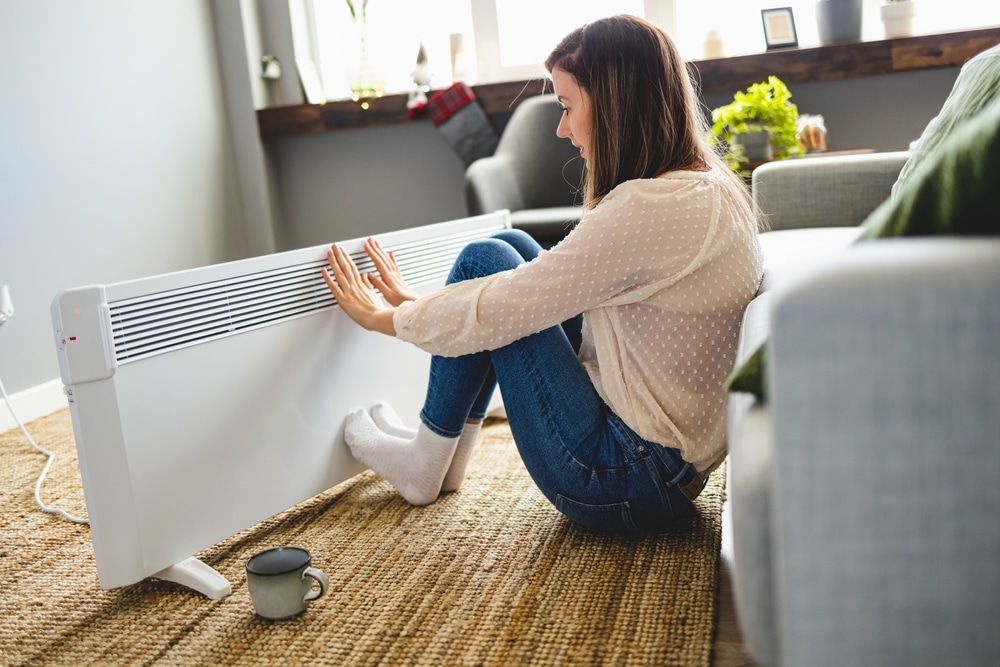Home > Energy Plans > Winter Energy Guide
Winter Energy Guide
Are you wondering how to survive a cold winter without your power bills going through the roof? Find out how to save energy in winter here with Savvy.
Author
Savvy Editorial TeamFact checked

As the southern states shiver through a cold winter, staying warm and comfortable is a top priority for all Aussies in the southern areas. We all know that winter can bring with it much higher energy bills. In this comprehensive Savvy guide, we'll provide you with valuable tips, tricks, and advice on how to conserve energy, make your home more energy-efficient, and keep your heating costs under control this winter. Let's make this winter a season of warmth without breaking the bank!
How can I stay warm in winter without breaking the bank?
Are you suffering from electricity bill shock, and wondering how to stay warm this winter? As electricity and gas prices soar in Australia, many people are wondering how to stay warm without getting sky-high electricity and gas bills. You may not be able to influence the price of electricity or gas, but there are lots of things that you can do to reduce your energy costs and to make your home more energy efficient. Areas we’ll look at include:
- Making your home more energy efficient
- Using available heating wisely
- Choosing the right heating appliance
- How to understand the cost of running heaters
Making your home more energy efficient
Where is all my warmth going?
In a typical Australian home, here’s where all your heat is getting lost:
- Ceiling: About 25-35% of heat is lost through the ceiling.
- Walls: Approximately 15-25% of heat is lost through the walls of a typical home.
- Windows: Around 10-20% of heat is lost through the windows of the house.
- Doors and air leaks: Approximately 15-25% of heat is lost through doors and air leaks.
- Floor: About 10-20% of heat is lost through the floor of the home.
How to reduce heat loss in your home:
Reducing heat loss in your home is essential for keeping it warm and cosy during the colder months. Here are some simple and effective ways to achieve this:
- Insulate the attic: Properly insulate the attic to prevent heat from rising and escaping through the roof.
- Seal gaps and cracks: Identify and seal any gaps or cracks around windows, doors, and air conditioning vents to prevent warm air from escaping, and cold air from entering. Close air conditioning vents if they are not being used in the winter.
- Use thick curtains: Use thick, insulated curtains to cover windows at night, keeping warmth inside and blocking cold drafts.
- Close off unused rooms: Close doors to unused rooms to concentrate the heat in the areas you are actively using.
- Use door draught stoppers: Place draught stoppers under doors to prevent warm air from escaping underneath.
- Use draft excluders: Install draft excluders around windows to prevent heat loss and cold drafts.
- Use thick rugs and carpets: Use rugs and carpets on cold floors to add an extra layer of insulation to stop the cold from rising up, and to keep your feet warm.
How to use available heating wisely
Using your available heating wisely is crucial to stay warm and comfortable during winter. Here's a few handy hints on how to do so and so keep your energy bill under control:
- Use an optimal heat temperature: Set your thermostat to a comfortable temperature range of 18°C to 21°C. Each degree lower can save up to 10% on heating costs.
- Buy programmable thermostats: Invest in programmable thermostats to set the temperate of your home. Lower the temperature at night or when you're not at home to save energy.
- Adjust your louvres: If you have a heating system with adjustable louvres, direct warm air downwards, because hot air rises. This ensures the heat is evenly distributed in the room.
- Set your ceiling fans to their winter direction: Most ceiling fans have two different directions to direct the air either up or down in a room. Ensure you set your ceiling fans to the winter setting to force warm air downwards.
- Zone heating: Divide your home into zones by closing doors to unused rooms. Only heat the areas you're actively using, reducing energy wastage.
- Invest in curtain pelmets: Use thick curtains with curtain pelmets to reduce heat loss, preventing warm air from escaping and reducing the need for excessive heating.
- Utilise daylight solar energy: Utilise sunlight during the day by keeping curtains and blinds open to let natural warmth in. Close them at night to retain the heat.
- Maintain your heating system: Regularly service and maintain your heating system to ensure they run efficiently and reduce energy waste.
- Check energy rating labels: Check the energy rating labels of heating appliances to compare their efficiency and running costs so you’re aware of which heating systems are most efficient to run.
By incorporating these tips and using heating wisely, you can enjoy a warm and cosy home during winter while minimising energy consumption and saving on heating costs.
Choosing the right heating appliance
Selecting the appropriate heating appliance is crucial to ensure comfort, efficiency, and cost-effectiveness during winter. Consider these factors when deciding on the best heating option for your home:
- Room size and heating capacity: Look at the size of the room you want to heat. Smaller rooms may be heated with an electric rug or blanket for personal warmth for one or two people. A small reverse cycle air conditioner can effectively heat a small to medium sized room. For larger areas, zoned heating systems or whole-house solutions may be necessary.
- Energy efficiency: Look for heating appliances with high energy star ratings. Energy-efficient heaters can significantly reduce your energy consumption and lower utility bills.
- Running costs: Compare the purchase, installation, and running costs of different heating options. Factor in the appliance's lifespan and warranty to make an informed decision.
- Convenience features: Consider additional features like timers, remote controls, child locks, and adjustable settings for optimal comfort and convenience.
- Safety: Safety is crucial, especially if you have children or pets. Look for heaters with safety features like tip-over protection and cool-touch exteriors.
- Zoning and zoned ducted systems: Zoning allows you to heat specific areas of your home, reducing energy waste. Zoned ducted systems offer efficient whole-house heating, allowing temperature control in different areas at different times of day.
- Electric vs. gas: Weigh the pros and cons of electric and gas heaters. Electric heaters are generally more affordable upfront, while gas heaters may have lower running costs, depending on gas prices and consumption.
Ultimately, the right heating appliance will depend on your specific needs, budget, and your home setup. Take time to research different options, read customer reviews, and consider professional advice to make an informed choice. A well-chosen heating appliance will provide cozy warmth while being kinder to both the environment and your wallet during the winter months.
What is the cheapest type of heater to run in winter?
The cheapest type of heater to run in winter can vary based on factors such as energy efficiency, room size, and local energy prices. Generally, heating methods that utilise electricity tend to have higher running costs compared to those using gas. However, some specific examples can help illustrate the cost-effectiveness of different heaters:
- Heated throw rug (electric): The running costs for a heated throw rug on a flat rate electricity tariff range from 3-5 cents per hour. During time-of-use tariffs, the cost can be 2-3 cents during shoulder hours, 3-4 cents during off-peak hours, and 4-5 cents during peak hours. This type of heater is suitable for 1 or 2 people who are not very active.
- Heated blanket (electric): The running costs for an electric heated blanket are similar to a heated throw rug, with flat rate tariffs ranging from 4-5 cents per hour and time-of-use tariffs varying from 2-3 cents during shoulder hours, 3-4 cents during off-peak hours, and 4-6 cents during peak hours. It is also suitable for 1 or 2 people who are not very active.
- Radiant heater (electric): Radiant heaters have higher running costs, with flat rate tariffs ranging from 31-45 cents per hour and time-of-use tariffs varying from 20-27 cents during shoulder hours, 23-32 cents during off-peak hours, and 36-49 cents during peak hours. This type of heater is suitable for 1 or 2 people who are not very active.
- Small reverse cycle air conditioner: The running costs for a small reverse cycle air conditioner are relatively lower, with flat rate tariffs ranging from 8-11 cents per hour and time-of-use tariffs varying from 5-7 cents during shoulder hours, 6-9 cents during off-peak hours, and 10-13 cents during peak hours. This type of heater is suitable for small room spaces with a floor space of around 12m².
- Electric panel heater: Electric panel heaters have higher running costs, with flat rate tariffs ranging from 37-50 cents per hour and time-of-use tariffs varying from 24-33 cents during shoulder hours, 28-38 cents during off-peak hours, and 43-58 cents during peak hours. This type of heater is suitable for small room spaces with a floor space of around 12m².
- Electric portable fan heater: Electric portable fan heaters have the highest running costs among electric heaters, ranging from 75 cents to $1.01 per hour on flat rate tariffs and varying from 48-65 cents during shoulder hours, 56-76 cents during off-peak hours, and 87 cents to $1.17 during peak hours on time-of-use tariffs. This type of heater is suitable for small room spaces with a floor space of around 12m².
- Reverse cycle air conditioner (large room): For larger spaces, a reverse cycle air conditioner has relatively lower running costs, with costs ranging from 29-39 cents per hour, and time-of-use tariffs varying from 19-25 cents during shoulder hours, 22-29 cents during off-peak hours, and 35-45 cents during peak hours. This type of heater is suitable for larger room spaces with a floor space of around 39m².
- Gas heater: Gas heaters have a running cost ranging from 42-80 cents per hour, and are suitable for larger room spaces with a floor space of around 39m².
- Small combustion fire: Small combustion fire costs are 58-79 cents per hour, and are also suitable for larger room spaces with a floor space of around 39m².
- Zoned ducted reverse cycle air conditioner: Zoned ducted reverse cycle air conditioners have higher running costs, ranging from $1.17 to $1.58 per hour on flat rate tariffs and varying from 76 cents to $1.02 during shoulder hours, 88 cents to $1.19 during off-peak hours, and $1.35 to $1.82 during peak hours on time-of-use tariffs. These are suitable for whole-house floor spaces of around 200m².
- Zoned ducted gas heating: Zoned ducted gas heating has the highest running costs, ranging from $2.44 to $2.70 per hour on flat rate tariffs, and is suitable for whole-house floor spaces of around 200m².
The most cost-effective heating option will depend on your specific heating needs and the energy prices in your location. Using thermostats to control heating levels, and limiting heating to occupied rooms only can help reduce overall heating costs during winter.
Helpful energy guides
Compare energy plans
Disclaimer:
Savvy is partnered with Econnex Comparison (CIMET Sales Pty Ltd, ABN 72 620 395 726) to provide readers with a variety of energy plans to compare. We do not compare all retailers in the market, or all plans offered by all retailers. Savvy earns a commission from Econnex each time a customer buys an energy plan via our website. We don’t arrange for products to be purchased directly, as all purchases are conducted via Econnex.
Any advice presented above is general in nature and doesn’t consider your personal or business objectives, needs or finances. It’s always important to consider whether advice is suitable for you before purchasing an energy plan. For further information on the variety of energy plans compared by Econnex, or how their business works, you can visit their website.










